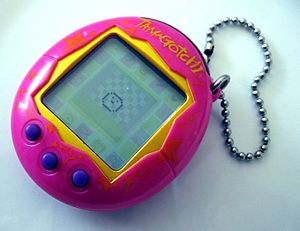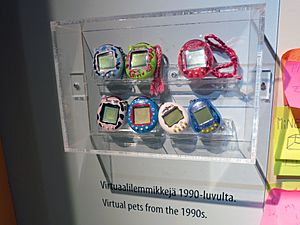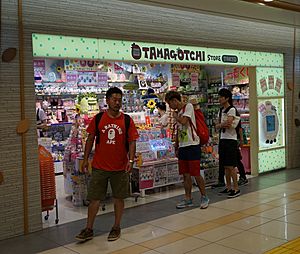Tamagotchi facts for kids

Tamagotchi Connection V1, released in 2004
|
|
| Type | Digital pet |
|---|---|
| Inventor(s) | Aki Maita |
| Company | Bandai |
| Country | Japan |
| Availability | 1996–present |
The Tamagotchi (Japanese: たまごっち, "Egg Watch") is a small, handheld digital pet. It was created in Japan by Akihiro Yokoi of WiZ and Aki Maita of Bandai. Bandai first released it in Japan on November 23, 1996. It came to the USA on May 1, 1997.
The Tamagotchi quickly became a huge toy fad in the late 1990s and early 2000s. By 2021, over 83 million units had been sold worldwide. Most Tamagotchi toys are egg-shaped. They have a screen and three buttons to play with your digital pet. The Tamagotchi Pix even has a camera!
The name "Tamagotchi" is a mix of two Japanese words. "Tamago" means "egg," and "uotchi" means "watch." So, it's like an "Egg Watch."
Contents
History of Tamagotchi Pets

Aki Maita and Akihiro Yokoi invented the Tamagotchi in 1996. They even won an award, the 1997 Ig Nobel Prize for economics, for their invention! Tamagotchi is a keychain-sized digital pet game.
The characters are colorful creatures. They look like simple animals, objects, or people. In 2004, new Tamagotchi toys came out. These included the Tamagotchi Plus/Connection. They had new designs and more detailed gameplay.
The basic story stayed the same. Tamagotchis are small alien creatures. They send an egg to Earth to learn about life. It's your job to raise the egg into an adult. The creature grows through different stages. How you care for it changes how it develops. Better care means a smarter, happier pet that needs less attention.
When Tamagotchi first came out in Japan, Bandai sold them mostly to teenage girls. Later, Bandai and WiZ made a boy version called the Digital Monster. This led to the popular Digimon series.
How to Play with Your Tamagotchi
When you turn on your Tamagotchi, an egg appears. You set the clock, and after a few minutes, the egg hatches! In newer versions, you can also enter your name and birthday. You can even name your new pet.
You decide how much to care for your pet. Your actions affect how it grows. Early Tamagotchis could only be paused by changing the clock. Newer models have a special pause function.
Your pet has a Hunger meter, a Happy meter, and a Training meter. These show how healthy and well-behaved your pet is. You can also check its age and weight.
- Feeding: Fill the Hunger meter by giving your pet a meal (like bread or a hamburger) or a snack (like candy or cake).
- Playing: Fill the Happy meter by playing mini-games with your pet. Snacks also make them happy.
- Discipline: If your pet calls for attention but won't eat or play, you can scold it. This fills the Discipline meter.
- Cleaning: Your pet will leave droppings. If you don't clean them, your pet can get sick. Before it goes to the bathroom, it makes a face. If you use the toilet icon then, your pet will use the toilet. Doing this often can potty train your pet.
- Training: Good care fills the Training meter. When it's full, your pet will evolve right away!
If your pet gets sick, a skull icon appears. It might get sick from too many snacks or not cleaning up droppings. If you don't give it medicine, your pet can die. You might need to give medicine more than once. Sick pets usually won't play or eat.
Life Cycle of Your Pet
Your pet goes through different stages as it grows. Each stage lasts a certain number of days. When it reaches a new stage, the toy plays a sound, and your pet's look changes.
Pets can "die" from poor care, old age, or sickness. In some versions, predators can also cause death. The stages are Baby, Child, Teenager, Adult, and Special. There used to be a Senior stage. Your pet's age usually increases when it wakes up from sleep.
If an old pet dies without having babies, its family line ends. Japanese Tamagotchi toys show a ghost and a headstone when a pet dies. English versions show an angel instead. You can see the age your pet died by pressing the C button. To restart the game after a pet dies, press the A and C buttons at the same time.
Extra Features of Tamagotchi

In newer models, you earn Gotchi Points by playing games. You can use these points in an in-game shop. You can buy different foods, toys, accessories, or even room decorations for your pet.
Connecting with Friends
Some Tamagotchi toys can connect using infrared. Two players can link their toys. Their pets can become friends, play games, exchange gifts, and even get married! This feature started with the Osutchi and Mesutchi models.
The Japanese Keitai Kaitsuu Tamagotchi Plus was the first to have an app. Many newer models can connect to apps like Tamatown. You use codes from your toy to log into the website's Flash game. You can play mini-games to earn Gotchi Points or buy items. Then you get a code to transfer points and items back to your toy.
Newer models like the Tamagotchi 4U can connect to other 4U units. They can also connect to smartphones and tablets using near-field communication.
Marriage and Family Life
The Mesutchi and Osutchi Tamagotchis were the first to have marriages and babies. This feature returned in the Plus/Connection and later models. Two players with a male and female pet can link their toys. The pets can become friends and fall in love. Once their relationship is strong enough, they can marry. You can also have your pet marry a random pet from a "Matchmaker."
After marriage, the female pet will lay two eggs. She keeps one, and the male gets one. The parent pet guides the baby's life. The only care it needs from you is medicine if it gets sick. After 24 hours, or when the baby becomes a child, the parent leaves. Then you care for a new generation. This can continue as long as you care for the pets.
The Chou Jinsei Enjoy Tamagotchi added "families" or "groups" of characters. These groups classify characters by their look and skills. A character from one group cannot grow into an adult of a different group. If two pets from different groups marry, the baby will be from the female's group. The Tamagotchi M!X changed this. In this version, Tamagotchi babies get traits from both parents!
Other Cool Features
Many different versions of the toy have other ways to influence your pet's growth. These include how friendly your pet is with you, different types of skills, and even careers.
The Chou Jinsei Enjoy Tamagotchi also introduced Skills. You can build skills by playing certain games or using toys and foods. Having certain skills can help your pet get a career. If skills are high enough, you can unlock special characters.
The Tamagotchi Pix has a camera. You can get a pet based on your skin tone and age. You can also take pictures and "take" your pet on a walk!
Tamagotchi Releases and Games
As of 2009, over 44 Tamagotchi versions have been released. Some were only released in Japan. The first Tamagotchi toys included Christmas, angel, and ocean themes. Newer versions started in 2004 with the Tamagotchi Plus. The newest version in Japan is Tamagotchi Smart, and in the West, it's Tamagotchi Pix.
Bandai sold 400,000 units in 1996. This grew to 10 million by July 1997. By 2017, over 82 million units had been sold worldwide. By March 2021, Bandai Namco had sold 83.73 million Tamagotchi units.
In 2013, Bandai released a free app called "Tamagotchi L.i.f.e." for iOS and Android. A sequel, "Tamagotchi L.i.f.e. Angel," came out in 2014. "Tamagotchi ON" was the first color Tamagotchi released worldwide. Bandai also released special editions for collectors, like "Tamagochi: Neon Genesis Evangelion" in 2020.
Tamagotchi Video Games
Since it first came out, Tamagotchi has appeared on many gaming platforms. Some early games were similar to the original toys. There were also party-style games on major consoles. The Corner Shop series of simulation games and some role-playing games came out for the Nintendo DS.
| Game | Device | Distribution | Release | Sales |
|---|---|---|---|---|
| Tamagotchi (Game de Hakken!! Tamagotchi) | Game Boy | International | 1997 | 3,000,000 |
| Game de Hakken!! Tamagotchi V2 | Game Boy | Japan | 1997 | 1,450,000 |
| Game de Hakken!! Tamagotchi Osutchi to Mesutchi | Game Boy | Japan | 1997 | |
| Tamagotchi 64: Minna de Tamagotchi World | Nintendo 64 | Japan | 1997 | |
| Hoshi de Hakken!! Tamagotchi | PlayStation | Japan | 1998 | |
| Sega Saturn de Hakken!! Tamagotchi Park | Sega Saturn | Japan | 1998 | |
| Tamagotchi Town | Super Famicom | Japan | 1999 | |
| Tamagotchi Connection: Corner Shop | Nintendo DS | International | 2005 | |
| Tamagotchi Connection: Corner Shop 2 | Nintendo DS | International | 2006 | |
| Tamagotchi: Party On! | Wii | International | 2006 | |
| Tamagotchi Connection: Corner Shop 3 | Nintendo DS | International | 2007 | |
| Tamagotchi no Furifuri Kagekidan | Wii | Japan | 2007 | |
| Tamagotchi no Narikiri Channel | Nintendo DS | Japan | 2009 | |
| Tamagotchi no Narikiri Challenge | Nintendo DS | Japan | 2010 | |
| Tamagotchi Collection | Nintendo DS | Japan | 2011 | |
| Ouchi Mainichi Tamagotchi | Nintendo 3DS | Japan | 2012 |
| Game | OS/Device | Distribution | Release | Sales |
|---|---|---|---|---|
| Tamagotchi CD-ROM | Windows 95 | International | 1998 | 250,000 |
| Tamagotchi L.I.F.E. | Android, iPod Touch, iPad, iPhone | 2013 | ||
| Tamagotchi L.I.F.E. Angel | Android, iPod Touch, iPad, iPhone | 2013 | ||
| Tamagotchi L.I.F.E. Tap and Hatch | Android, iPod Touch, iPad, iPhone | 2013 | ||
| Tamagotchi Classic -Original- | Android, iPod Touch, iPad, iPhone | 2015 | ||
| My Tamagotchi Forever | Android, iPod Touch, iPad, iPhone | 2018 |
Arcade Games
The character Mametchi appears in Namco Bandai/Nintendo's Mario Kart Arcade GP 2. He is a playable character, and his pet, Bagubagutchi, is an item. Mametchi and Yumemitchi also appeared in the arcade game Taiko no Tatsujin as costumes you could unlock.
In Japan, there's an arcade machine called TamaStation. Players can win prizes for their Tamagotchi toy. This machine has several sequels, like TamaStation 2.
Tamagotchi in Media
Tamagotchi Movies
On June 5, 2007, it was announced that an animated Tamagotchi film would be released. The movie, Tamagotchi: The Movie, came out on December 15, 2007. It stars Mametchi and his friends Memetchi and Kuchipatchi. A human girl named Tanpopo is also in the movie. Mametchi accidentally brings her to the Tamagotchi Planet. Mametchi's younger sister, Chamametchi, is born during the film. The movie opened at number 3 at the box office.
A second film, Tamagotchi: Happiest Story in the Universe!, was released on December 20, 2008. This movie introduced a new Tamagotchi named Hapihapitchi. An English version of this movie aired on TV in the Philippines.
On November 1, 2016, Bandai announced a new short film. It was called Tamagotchi: Secret Delivery Operation. It was released in theaters on April 28, 2017. The short film follows Mametchi and his friends. They need to make an important delivery to the Gotchi King. But the Spacy Brothers try to stop them!
In the 2022 movie Turning Red, which takes place in 2002, the main character Mei Lee has a Tamagotchi. She names it "Robaire Junior" after her favorite band member. The movie's director, Domee Shi, wanted a Tamagotchi when she was younger.
Tamagotchi in Other Video Games
In Call of Duty: Modern Warfare (2019), you can buy an item called the Tomogunchi. It's like a Tamagotchi on a wristwatch. It has a virtual animal that grows as you get kills and win matches.
A Tamagotchi also appears in the game Chibi-Robo!. It's a gift you can give to a character after finishing the main story. Bandai helped make Chibi-Robo!, so they could include the Tamagotchi.
In the mobile game Pixel Gun 3D, there's a weapon called the Tamagotchi Revolver. It's a small pink gun with a Tamagotchi on it.
Tamagotchi Anime Shows
A Japanese-only anime series called Anime TV de Hakken!! Tamagotchi aired from 1997 to 1998.
In December 2007, Bandai Japan started airing Saa Ikō! Tamagotchi. In 2008, Bandai America dubbed the series, Let's Go! Tamagotchi. They streamed it on YouTube in English and Japanese.
In 2009, another anime TV series was announced, called Tamagotchi!. It ran from October 2009 to March 2015. An English version of the anime aired in Australia. It was also dubbed in other languages, like Tagalog in the Philippines.
From 2013 to 2014, Bandai America adapted the second Tamagotchi anime, Tamagotchi! Yume Kira Dream. They made "webisodes" to promote the Tamagotchi Friends toy.
Animated Video
An animated video called Tamagotchi Video Adventures was made in 1997. In it, Cosmotchi sends the Tamagotchi to Earth. They need to find an object that best shows what Earth is like for the Tamagotchi Museum.
Tamagotchi Music
- The band Sqeezer made a song called "Tamagotchi (Tschoopapa...)" in 1997.
- In Japan, the band Kigurumi released their song "Tamagotchi" in 2007. It was the theme music for the first movie.
- The Eurodance group Daze used many Tamagotchi references in their song "Together Forever."
- The Los Angeles pop duo LOONER released "I Love My Tamagotchee!" in 2009.
- The Filipino band Eraserheads made a song called "Tamagotchi Baby."
- The German band "Die Ärzte" also made a song called "Tamagotchi."
- The French singer Lorie made a song called "La TamaDance" in 2014.
- The Tamagotchi! anime has many original songs. Most are sung by the Japanese voice actress Kei Shindō as the pop idol Lovelitchi.
- Polish rapper duo Taconafide released their song Tamagotchi in 2018. It reached number 1 on many Polish music charts.
|
See also
 In Spanish: Tamagotchi para niños
In Spanish: Tamagotchi para niños
- Digimon — another similar digital pet by Bandai
- Giga Pet — a brand of virtual pets that competed with Tamagotchi
- Fin Fin on Teo the Magic Planet — a similar digital pet game
- List of Tamagotchi releases
- Pixel Chix — a similar toy for girls
- Pou — a game like Tamagotchi where you care for a virtual creature
- Tamagotchi effect — a psychological idea named after the digital pet
- Tuttuki Bako — another interesting Bandai toy
- Pokémon Pikachu — a similar line of digital pets by Nintendo





